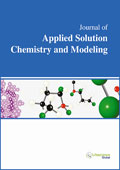jascm
|
|
Abstract: New chiral salen-type Cu(II) complexes (1-9) were prepared, and the effects of different substituent groups on their absorption spectra were evaluated using time-dependent density functional theory (TD-DFT). Electron withdrawing groups resulted in a red-shift and an increase in the peak intensity. According to cyclic voltammetry analyses, the introduction of electron withdrawing groups brought the redox potentials (E0) in agreement with the orbital level energies determined via TD-DFT. The reduction potentials for 1-9 are less than −0.500 V, and therefore, it is electrochemically possible to dope electrons in TiO2. In addition, the oxidation potentials are greater than +0.200 V, indicating that it is electrochemically possible to regenerate the dyes. Preproduction dye-sensitized solar cells (DSSCs) fabricated using compounds 1-9 generated electricity. In particular, the DSSC prepared using 2 (which has electron withdrawing groups and the largest maximum absorption) exceeded the power conversion efficiency of DSSC fabricated using N3, which is a commonly used Ru(II) complex. Keywords: DSSC, Copper(II), Schiff base, Chirality, Crystal structure.Download Full Article |
|
|
Abstract: Sols with stable dispersion of layered titanate nanoparticles were prepared at 298 K using dialysis of a mixed solution of ethylene glycol, TiCl3, ammonium carbonate, and H2O2. Raman spectra of the particles in the obtained sols showed Raman scattering peaks which can be assigned to a layered titanate structure. The stability of the obtained sols depended on the molar ratio of [ammonium carbonate] / [Ti ion]. The molar ratios of 3, 4, and 5 produced transparent yellow stable sols. Peptization of titanium hydroxide precipitate with H2O2 formed stable sols with dispersion of layered titanate nanoparticles, which had plate - shaped morphology. The obtained sols formed layered titanate thin films on glass substrates easily by drying the sols. Furthermore, when the layered titanate thin films were heated at 773 K for 1 h, anatase TiO2 thin films were obtained with (101) orientation of crystallites and optical transparency. Keywords: Nanostructures, Oxides, Thin films, Sol-gel, Peptization, Coatings.Download Full Article |
|
|
Abstract: This paper reports densities at atmospheric pressure and at three temperatures T = (283.15, 298.15, and 313.15) K of eight binary mixtures involving a branched hexane (3-methylpentane or 2,2-dimethylbutane) and each one of the isomeric chlorobutanes (1-chlorobutane, 2-chlorobutane, 1-chloro-2-methylpropane or 2-chloro-2-methylpropane). Excess volumes were calculated from experimental densities and correlated with the Redlich-Kister equation. Moreover, the excess volumes were analysed using the Prigogine-Flory-Patterson theory. Keywords: Branched hexane, Isomeric chlorobutane, Prigogine-Flory-Patterson theory, Volumetric behaviour.Download Full Article |
|
|
Abstract: Using the evaporating method, the solubility of sodium chlorate was determined in the various mixed solvents (water + ethanol + propanol) at various temperatures. The results showed that the solubility of NaClO3 decreases with increasing the mass percent of ethanol and propanol. On the other hand, the solubility of NaClO3 increases with increasing the temperature .In addition, the equilibrium constant of ion pair formation, KIP, for the reaction Na+(aq) + ClO3-(aq) Na+ClO3- (Ion Pair) was estimated upon Fuoss contact ion pair model and then, the values of ion-pair concentrations were determined by using the extended Debye-Hückel model and iteration calculations in various mixed solvents and various temperatures . Finally the value of thermodynamic solubility product constant, Ksp(th), and the values ΔH°, ΔS° and ΔG° of and of ion-pair formation were estimated in the mixed solvent media. Keywords: Mixed solvent, The extended Debye-Hückel model, Ion- pair, Thermodynamic function.Download Full Article |
|
|
Abstract: In modeling the regions of precipitation and formation of thin films, we used four conditions: 1. The rule of solubility product; 2. The rule of molecular solubility; 3. The rule of solubility by intermediate; 4. Condition of precipitate of priority. This technique was used to build mathematical models of equilibriums from the pH of solution, concentration of reactants, and temperature. Mathematical models were also developed on the basis of experimental data obtained by potentiometry, residual concentration, thermogravimetry, etc. This model considers fluctuations of the pH of solution and predicts the chemical composition of compounds. It has been demonstrated that in synthesizing target compounds, the possibility of processes of fluctuations must be taken into account. A systemic mathematical model has been designed to optimize the synthesis of thin films and target compounds. Keywords: Mathematical modelling of equilibriums; conditions of saturation of aqueous solutions; the thin films of the lead sulfide.Download Full Article |



